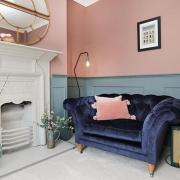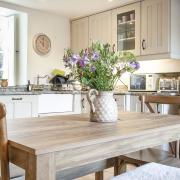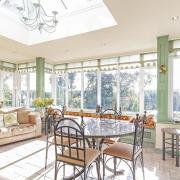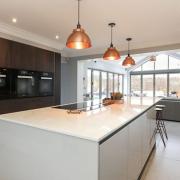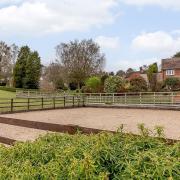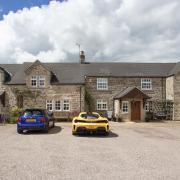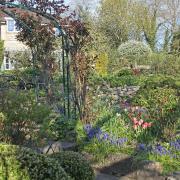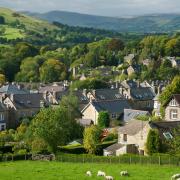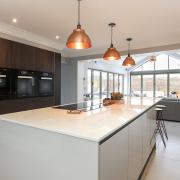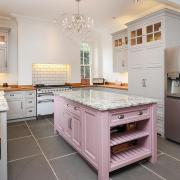Derbyshire Life discovers two inspiring stories that highlight the importance in our lives of finding a place of our own

According to the 2011 Census, 1.6 million people in England and Wales have a second home in the country that they use for a month or more each year. Even more of us have refuges in our own grounds in the form of separate buildings, sheds, gazebos or garden huts. We talk with two determined and resourceful people who can shed light on our craving for a ‘home from home’.
THE RETURN OF THE SHEPHERD’S HUT
Allan Gagen-Hill is a maker of shepherds’ huts, modern versions of the type of huts that were once used on large farms during sheep-raising and lambing times. The huts were towed to remote areas of the farms and were fitted out so that the shepherd could keep warm, prepare food and sleep overnight if necessary whilst looking over his flock. In recent years, there has been a revival of demand for these huts, not for their traditional purpose, but for a wide variety of modern uses, from garden sheds, writing dens and offices to guest accommodation, holiday homes and summer houses.

Allan has been manufacturing shepherds’ huts for the last three years. He lives in a 300-year-old farmhouse at the foot of Combs Moss, a Peak District hill with a profile reminiscent of Table Mountain. He bought the property ten years ago and began carrying out a renovation to transform the building into a fine home for himself, his wife, Rosemary, and their two children, Sam and Henry.
For 17 years, Allan ran a taxi service to transport special needs children to schools in the High Peak, but he lost his contract three years ago due to cost-cutting moves by Derbyshire County Council. Recalling the moment when his major source of income disappeared, Allan said: ‘I have always tried to turn a negative into a positive and I realised that losing the contract could actually do me a favour. For some years, I had wanted to set up my own business and now was the time to take the plunge.’
When he was a schoolboy, Allan suffered horrific injuries in a traffic accident. While slowly recuperating, he missed months of schooling in the period leading up to his GCSE examinations. As a result, he left school with no qualifications, but a sympathetic and supportive careers teacher at Chapel-en-le-Frith High School asked the Dorothea Restoration Company to give Allan a chance to work at their firm, which renovates heritage architectural ironwork.
Looking to capitalise on the skills he learned at Dorothea and the expertise he acquired whilst renovating his farmhouse, Allan trawled the internet before coming up with the idea of manufacturing shepherds’ huts, which were becoming very popular with holidaymakers wanting to stay in a romantic hideaway and for people wanting to acquire warm and comfortable refuges.

The walls of Allan’s huts are made from pine, protected with four coats of paint. Their roofs are constructed from corrugated iron, and the wheels and the tow bar are manufactured from cast-iron by a firm in Northampton. Allan installs electrical sockets and fittings, inserts a wood-burning stove and adds a bed or other furniture as required. The door can take the form of a stable door at the end opposite the tow bar or wide side-doors like those traditionally found in a river keeper’s hut. A distinctive trade mark in Allan’s huts is that one of the windows is made of reclaimed stained glass.
Allan is currently completing his tenth shepherd’s hut. Recalling some of the uses that have been found for his products, he said, ‘These include: a summer house; an office; a spare room; a weekend retreat; a play space for children; a means of building an extension that could be taken with the family if they were ever to move to a new house; and a temporary home overlooking the sea for a vicar who had moved to a new parish in Cornwall.’
Clearly passionate about his new business as a maker of individually-styled shepherds’ huts, Allan said, ‘If I had not decided to turn a negative into a positive when I lost my taxi contract, I would not now have the best job in the world.’
Allan Gagen-Hill’s shepherd’s huts can be viewed on the ‘Made in Derbyshire’ website and Allan can be contacted on O1298 815849 or on 07778752785.

A HOUSE REBORN
Back in 1969, Jennie Powell, a language teacher, and her husband, Dave, a computer engineer, shared what seemed like an impossible dream. The couple had been married for three years and were living in Sheffield with their two small daughters. Having enjoyed a number of holidays at a cottage owned by Dave’s father in Anglesey, they longed to have a holiday home of their own in the area, but realised that their lack of capital was likely to prevent their dream becoming reality.
However, after spotting an advertisement for a property called Ty Lawr, located near to Cemaes Bay, the couple couldn’t resist paying a visit. Recalling their first impressions, Jennie said: ‘We fell in love with the house at first sight. Set in open countryside near the sea, Ty Lawr was a solid house with a cowshed and pigsties attached. All around there were flocks of sheep in fields full of yellow gorse. We first saw the house in bright sunshine, which imbued it with Anglesey’s special light.’

The purchase price was modest because of the condition of the house, which had a closure order on it as it did not comply with housing standards. There was no electricity and no running water. The toilet, a wooden bench two-holer, was an earth closet at the foot of the garden.
Rather than being daunted by the massive amount of work needed to make Ty Lawr habitable, Jennie and Dave were seduced by the stunning location and fired with enthusiasm about the improvements they would make, even though they had no experience of the sort of work that would be required. They would need to provide a septic tank, pipe in mains water, install electricity, excavate floors to put in a damp course and knock down internal walls to open up the tiny rooms.
After begging and borrowing money from parents, in-laws and the bank, they managed to raise the £950 purchase price and Ty Lawr became theirs. Whilst they carried out the demolition work during fortnightly working weekends in Anglesey, their two daughters played games with the big black beetles that lived under the floor and the woodlice that emerged from partition walls. Recalling the day when a defunct cooking range was ripped out to reveal a huge inglenook fireplace, Jennie said, ‘In my imagination, I could almost smell the bread baking and feel the heat of the fire.’
Demolition was relatively easy, but construction was far harder and slower, because the couple were complete novices as builders. Much-needed late afternoon breaks were taken in the surrounding countryside, which was revealed as a ready source of food: blackberries; elderberries; rhubarb; apples; damsons; gooseberries; kale and mushrooms. For the girls, the fields and the sea shore were ‘outdoor classrooms’, where they could learn about the natural world in an exciting hands-on way.

Despite the hard work involved, the many years spent making Ty Lawr into a home from home were immensely enjoyable, but tragedy struck when Dave was diagnosed with an inoperable brain tumour. After her husband’s death, Jennie bravely continued with the renovation, with the result that she has back problems to this day. She also used Dave’s life insurance money to finally complete the restoration work to which he had devoted so much energy and enthusiasm.
Another blow came when Jennie was diagnosed seven years ago with Parkinson’s Disease. After cherishing Ty Lawr for over 40 years, she has finally had to sell the house, but she has recalled those times by writing a moving and fascinating account of the joys and tribulations of renovating and owning a holiday home. Her little book will be an inspiration to anyone contemplating a similar move.
‘The Story of a House Reborn’ can be purchased by sending £6.50, inclusive of postage and packing, to Jennie Powell, 29 Westwick Crescent, Sheffield S8 7DL (0114 2376676). All proceeds will go to Parkinson’s UK to fund research that could one day lead to a cure for this cruelly progressive illness.






